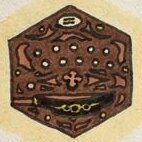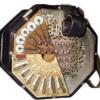Search the Community
Showing results for tags 'tuning'.
-
HOHNER English Concertina 48Key treble reveted action with accordion reeds. Push and pull should be F6, but E6 comes out by pushing. Can I tuning the reeds up one note? For this, I made a tuning bellows, but I have absolutely no skill in tuning.
-
Hi, This Christmas, a friend’s dad gave me an old Lachenal 30-button Anglo that had been in his family for generations. Unfortunately it is in a pretty sorry state, but as an aspiring musical instrument restorer, I have decided to have a crack at mending it myself (with the help of our friend's tools and DT experience). It is a beautiful instrument, with hardwood ends and bone buttons, steel reeds and a 5-fold bellows. As the photos show, it is a bit dirty (nothing some good cleaning can’t handle) and has had the bellows poorly repaired in the past with what looks like plasters…? Inside, the left hand reeds are quite rusty, while the right hand ones seem alright. The buttons also seem to be popping out of their guide holes, so they have to be wiggled around a bit before you can press them down. It also has some writing inside, saying it was tuned by a Wooding of Newcastle-under-Lyme in 1897, and an address that is only legible in bits, but appears to say: (something something something) 170 (something) road Cliff Vale Stoke-on-Trent Dec (something)/96 The main problems will be de-rusting the reeds and patching up the bellows (which have got more than their fair share of holes in). If anybody out there has any ideas or advice they could give me, whether that’s on the history of the instrument or how to repair it, it would be greatly appreciated by both me and my friend’s family. Please find attatched some photos of the instrument. Thanks! Here is a video of the state of the bellows:
-
This is a naive question about tuning! I'm looking at an old bandoneon that needs only spot tuning. Nobody local can really do it. I've tuned a couple of the outside reeds myself using the demo version of Dirk's software with pretty good results. For the inside reeds, I definitely need to remove the reed plate so it's more complicated. Presumably, I need a bellows, or even a table. I don't really have a shop or space to make one, other than kitchen table, so I'd have to purchase this. So I'm wondering is it possible to tune reeds without a bellows by twanging them on a resonant box like a tuning fork? Of course this would not accurately reflect the pitch when installed but then apparently neither does the external bellows. So, maybe, the procedure would be the same - 1) Use Dirk's to calculate the tuning adjustment for each octave set. 2) remove the reed plate, twang and adjust by the same amount 3) replace the reed plate and retest..... I have no idea if this is practical, hence the question. Cost factor - Dirks, 228 USD. Bellows from eBay, about 100 USD plus shipping. Of the two, Dirks actually seems most useful to me b/c of the ability to calculate both 8ve reeds at the same time.
-
I'm tuning a 30 key lachenal at the moment, and having some trouble with 2 of the reeds on the top row right side - I keep trying to sharpen them but it gets flatter. Both are long enough that it's not because of filing in the wrong place by mistake. On the charts I've seen, both should be d# in a lachenal, but the ones in mine are both eb, I don't know if that has anything to do with the problem. ANyone have any idea why this might be?
-
I am trying to patch up an old Chemnitzer. Using a good tuner, I find that it is on average between 340 - 380 cents below current concert pitch. Is it possible to tune to the reeds up to such an extent?
- 15 replies
-
- tuning
- chemnitzer
-
(and 1 more)
Tagged with:
-
I've been learning about tuning reeds, by embarking on retuning a brass-reeded Lachenal tutor to concert pitch from old philharmonic pitch. I bought it as a wreck some years ago and have been restoring it intermittently - see lachenal_52313.html. I realise that retuning is hard, and tedious, and I'm likely to make mistakes, but I'd prefer to make mistakes on this instrument which will never be a great one. A famous physicist once said that an expert is someone who has made all the possible mistakes in their subject! I've done a first pass on all the reeds, and now doing a second pass. It's all going reasonably well, except that I have three reeds which are within four cents of true pitch when blown gently, but when the pressure is increased slightly, they warble and go sharp. There was another like that, but by repeatedly tweaking the setting of the reed in the frame I managed to make it OK. However the remaining three (low Ds and B on RHS) are resisting my efforts. So, does anybody have any hints for how to correct that scenario? I've already tried cleaning the edge of the reed and the frame. Note that this happens when the reed is in an external tuning jig, as well as when re-inserted into the instrument, so it's nothing to do with the fit of the frame in the wood slot. It is of course quite possible that in my learning, I've manage to file the reed to a strange cross-section, so if nobody can suggest a solution, I could send the reeds off to Concertina Spares to be replaced or fixed, but I'd like to understand the cause of the problem and see if I can fix it myself if someone can suggest an approach. In general, are there any hints on setting of reeds beyond the description in Dave Elliot's Concertina Maintenance Manual? Regards,
-
Wondering if anyone has a good suggestion for an air pump for tuning and playing with reeds? I saw an earlier discussion that more-or-less concluded that an old bellows was the way to go. Probably OK for tuning, but I also want to do some experiments with reeds, and a constant-flow, hands-and-feet-free system would be preferable. Ideally quiet so as not to interfere unduly with measurements and recordings. Desirable to have suck and blow available. Don't want to spend a fortune though. Any bright ideas? Good to know too what people have tried and how well they have gone. Nice to know what traps one might fall into! Terry
-
Once upon a time, the accuracy and precision of tuning was all done by ear. I think we can all agree on this. The accuracy was determined by the accuracy of tuning forks and how that was transferred to master reed sets. The precision or repeatability of a tuning being down to the skill and ear of the tuner. When I first started in this game, I tried different meters, and looked for accuracy and repeatability in readings, I also looked at discrimination of displayed values, so if I was trying to tune to say +/- 5 cents, I needed to be able to measure at least 1/5th of the spread of the tolerance preferably 1/10th of the spread, or 1 cent in this case. So, Accuracy is in the actual value of the nominal value being achieved, assuming the meter shows no error for the note in question.So if the meter says A= 440 Hz, it is 440 Hz not 441, or 442 Hz). Precision = how close the the tuning technique, my skill and the repeatability of the meter allows me to get to the shown A= 440 Hz over, say 20 different occasions. All this is why engineers talk in tolerances. My next quest was to establish my own tuning tolerance standard, assuming an accurate measurement and a repeatable meter which would allow me read with an appropriate level of discrimination. I read-up various medical and musical papers and came upon the statement that most people can determine an error of 5 cents between two 'same' notes, some can say which of two notes is sharp or flat to the other, many cannot. I was taken be the statement that people can hear a dime fall. I took me quite some time to realise that a dime was 5 cents, but we don't have dimes in Yorkshire. This 5 cents detection was hearing two continuous notes, I reasoned that musical notes are transitory, a MM of 60 beats would give each note 1 second if playing crotchets, 1/2 a second if playing quavers, clearly MM 120 halves all this again, So +/- 2.5 cents seamed reasonable, say +/- 2 cents to allow for drift etc. Playing 3rds. 5ths & octaves I re-evaluated this to my current standard of +/- 1.5 cents from nominal across the range. The only exceptions being at a player's request or if a low pitched reed on an Anglo which can sometimes bend to flat when played above mp. I raise this topic as a result of working on two instruments for a certain player who could determine errors of less than 1 cent, by ear, and tell which note is the sharper of two , all this on an Anglo. The best I could manage was +/- 0.5 cents using a discrimination of 0.1 cents, and an instrumentation discrimination of probably 0.01 cents. Whilst I am quite happy to work to +/- 1.5 cents from nominal, and my various customers and players (except 1) are also happy with this, I wonder what tolerance other repairers are using. I will add that I get instruments brought to me for tuning tweaks that have been known (or reported) to have been serviced, tuned, repaired by others or before acquisition that can have several 5 cents or more variations from nominal. Some probably as a result of drift, but much as a result of rushed and sloppy workmanship. I can understand an inaccurately tuned instrument, say all notes 3 cents sharp, or say 2 cents flat, but not a wide spread in the overall precision of tuning. It would be good to determine an agreed standard, to protect players provide a control standard to repairers and guide home restorers alike. So I have declared my standard, what does the rest of the world do? Dave






